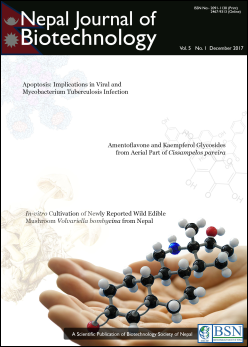Amentoflavone and Kaempferol Glycosides from the Aerial Parts of Cissampelos pareira
DOI:
https://doi.org/10.3126/njb.v5i1.18863Keywords:
Cissampelos pareira, Menispermaceae, Batulpate, Flavonoids, AmentoflavoneAbstract
Aerial parts of Cissampelos pareira L. (Family: Menispermaceae), commonly known as “Batulpate” in Nepal, are used for the treatment of fever, indigestion and to stop bleeding after child birth. In this study, a biflavonoid, amentoflavone; and two kaempferol glycosides, kaempferol 3-O-b-D-glucopyranoside and kaempferol 3-O-b-D-glucuronopyranoside were isolated from 70% MeOH extract of the aerial parts. Structures of these compounds were elucidated on the basis of 1H- and 13C-NMR spectral data. To the best of our knowledge, it is the first report on the isolation of these compounds from a plant belonging to family Menispermaceae.
Nepal Journal of Biotechnology. Dec. 2017 Vol. 5, No. 1:1-4
Downloads
Downloads
Published
How to Cite
Issue
Section
License
Copyright Notice:
The manuscript submitted to NJB must be an original contribution, not previously published and should not be under consideration for publication elsewhere. When the manuscript is accepted for publication, the authors agree to automatically transfer the copyright of the article to the publisher. It should grant permission to any third party, in advance and in perpetuity, the right to use, reproduce or disseminate your article, according to the NJB copyright and license agreement.
Authors transfer copyright to the publisher as part of a journal publishing agreement but have the rights to: Share their article for Personal Use, Internal Institutional Use and Scholarly Sharing purposes, with the NJB applies the Creative Commons Attribution-NonCommercial CC BY-NC license to all the works we publish after Jun 2020 (Before it was CC BY-NC-ND). Under this license, authors agree to make articles legally available for reuse, without permission or fees, for virtually any non-commercial purpose. Anyone may remix, adapt, and build upon your work non-commercially, and although their new works must also acknowledge you and be non-commercial, they don’t have to license their derivative works on the same terms. More details on CC BY-NC refer to its Licence Deed and Legal Code.






